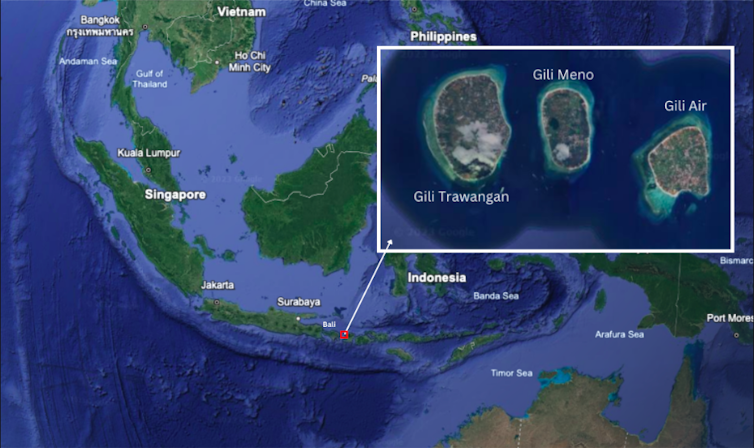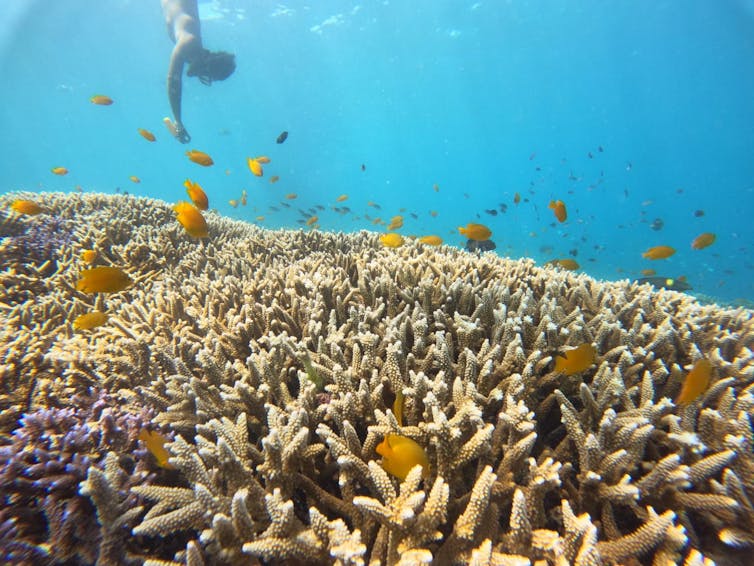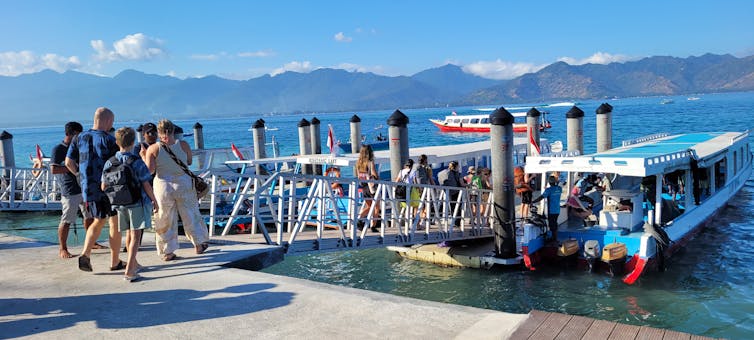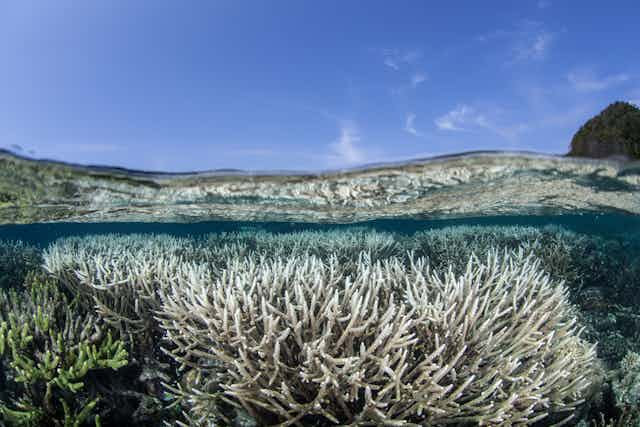This article is the first part of an in-depth science-based reporting series, supported by the Environmental Reporting from Asia-Pacific Island Countries grant by Internews’ Earth Journalism Network.
Sukding, the head of Gili Air Village in the Gili Matra National Marine Conservation Area in West Nusa Tenggara province, Indonesia, has vivid childhood memories of diving in the ocean near his village and playing with fish among the reefs.
In the 1980s, Sukding recalls, the area had abundant coral reefs, serving as a home to fish, lobsters, hawksbill turtles and white reef sharks.
“The entire coastline of this island (Gili Air) was packed with coral reefs,” Sukding told The Conversation in August, when we travelled more than 1,100 kilometres from Jakarta by plane and boat to meet Gili communities and see the reefs up close.

Four decades later, the situation has changed completely. The coral reefs in Gili Matra – short for three Gili islands, Gili Meno, Gili Air, and Gili Trawangan — are nearly wiped out.
Data from Indonesia’s Ministry of Maritime Affairs and Fisheries in 2022 stated that only about 247 hectares or approximately 10% of the total area of coral ecosystems in Gili survives.
Rising sea temperatures are the main reason behind the destruction. The area has experienced several extreme over the past 15 years, resulting in massive coral bleaching.
In 1998, extreme heat from El Niño decimated the coral reefs. The reefs used to cover 60-80% of the oceans’ floor in Gili Matra. Subsequent bleaching in 2010 and 2016 exacerbated coral damage in Gili Matra.
The problem remains.
Research published earlier this year, led by University of Glasgow marine ecologist Laurence De Clippele, indicates Gili Matra’s coral ecosystem is expected to face annual severe bleaching due to climate change from 2026 due to rising sea temperatures.
The research predicts Gili Matra will be among 12 of Indonesia’s marine protected areas where reefs will bleach every year by 2030. By 2044, they expect that to rise to reefs across 99 – or more than half – of Indonesia’s marine protected areas.
By around 2075, they expect to see annual bleaching affecting all 161 of Indonesia’s marine protected areas that are home to coral reefs, as the map above shows.
Some of areas set to be affected first include Selat Pantar – Alor Marine Conservation Area in East Nusa Tenggara province, where annual bleaching is expected to starts from 2026, and Waigeo Nature Reserve in Raja Ampat, West Papua, starting from 2028.
The De Clippele study, in collaboration with the World Wildlife Fund Indonesia and the Indonesian Ministry of Maritime Affairs and Fisheries, emphasises the importance of managing conservation areas in Indonesia. It also incorporates the risk of rising sea temperatures as one of its defining factors.
Indonesian reefs are globally significant
Indonesia is one of the largest homes for global coral reefs, accounting for 16% of the world’s total reef area. Its reefs are also known for their high coral diversity.
According to the 2021 G20 Climate Risk Atlas report by the Euro-Mediterranean Center on Climate Change, by the year 2050, Indonesia’s average sea temperature is expected to increase by approximately 1.1° to 1.5°C above the average temperature recorded between 1950 and 2014.
It will become a significant impediment to the Indonesia government’s goal to expand conservation areas from 28.9 million hectares to nearly 100 million hectares by 2045.
“The goal of our research is to provide knowledge on which areas require more support,” De Clippele told The Conversation Indonesia.
How bleaching can kill coral and affect marine life
Coral bleaching occurs when algae known as zooxanthellae detach from the coral’s surface. Consequently, the coral becomes stressed, as it doesn’t receive enough nutrients such as glucose, amino acids, and glycerol from the algae, causing the coral to bleach. When coral bleaches, they lose their vibrant colour and turn white.
One of its triggers is when the sea temperature increases to about 1-1.5°C above average temperatures for an extended period — about a month. Coral can also turn white because of pollution, too much freshwater, or too much sunlight.
Bleached coral can disrupt the food chain in ecosystems. Some coral-eating fish species, like parrotfish, will lose their food source. Additionally, other species, such as lobsters and turtles, may migrate because they lose their shelter and habitat.
Some Indonesian conservation areas, including Gili Matra, are predominantly inhabited by a coral genus called Acropora. Despite being fast-growing corals, they are vulnerable to environmental changes like rising sea temperatures.
“This species is considered vulnerable to heat. When there’s bleaching, they may die,” says Imam Bachtiar, a coral reef expert from the University of Mataram, West Nusa Tenggara.
This vulnerability has been evident. In June, Cakra Adiwijaya, a researcher from a local marine research organisation, Yayasan Gili Matra Bersama, discovered that coral reefs at one diving spot in Gili Air died due to skeletal eroding band disease.

The symptom includes the bleaching of the corals followed by black spots on their surface — believed to be a result of heat stress. At that time, according to Cakra, the monthly average sea temperature in the waters of Gili Matra reached 30°C or higher than the average temperature of around 28°C.
Imam Bachtiar stated that De Clippele research and the team’s findings significantly affect managing marine conservation areas. These areas – managed by national or regional governments – were supposed to serve as the ‘last line of defence’ for vital marine ecosystems like coral reefs, mangrove forests, and seagrass beds, protecting them from the busy shipping routes and industrial fishing activities.
Imam urges the Ministry to consider the De Clippele research seriously. This is because coral reefs serve as habitats for numerous marine organisms, including Vermiculated spinefoot fish, white-tip reef sharks, green sea turtles, and more.
The destruction of coral reefs will also affect local livelihoods, considering that 60% of Indonesia’s population resides in coastal areas and many depend on healthy coral ecosystems.
Protecting resilient coral reefs
De Clippelle’s study serves as a warning for the sustainability of Indonesia’s coral reefs in conservation areas. However, some things can be done.
The study predicted that 73 of Indonesia’s marine protected areas that are not expected to bleach annually until after 2044 could serve as “thermal refugia” – areas providing some refuge from the warming oceans. These refuge areas could include the Momparang Islands Marine Conservation Area in Bangka Belitung province and the Pangumbahan Coastal Turtle Sanctuary in Sukabumi, West Java province.
Similar to De Clippele’s study, Muhammad Erdi Lazuardi, the National Coordinator for Marine Science and Knowledge Management at WWF Indonesia, also points out that Indonesia has 16 coral ecosystem areas with high resilience to sea warming.
The number is based on a 2018 study by researchers from the University of Queensland, Australia, led by Ove Hoegh-Guldberg.
One of the most resilient coral ecosystems is located within the Selat Pantar - Alor Marine Conservation Area, in East Nusa Tenggara province, eastern Indonesia.
Hoegh-Guldberg’s study highlighted that this resilience was due to the coral reefs’ ability to endure ocean warming, thanks to their natural environment. The area has fewer storms and faces minimal risk of future sea temperature increases, allowing coral larvae to spread and thrive.
“The Alor Conservation Area is situated in a region with a high resilience of coral reefs, so if coral bleaching occurs in the future, it is expected to recover naturally,” says Erdi.
Nevertheless, Erdi warns that bleached-resilience corals will struggle to recover if the surrounding conditions are not supportive.
For instance, if there are practices of irresponsible fishing using bombs and potassium, polluted water, or excessive tourism.
He suggests enforcing patrols and monitoring conservation areas by government and local communities, restoring damaged corals, and promoting sustainable fishing and tourism activities. Currently, tracking in conservation areas aims to deter destructive fishing, large ships and other suspicious activities.
Erdi also views the Indonesian government’s initiative to map the capacity of tourism within the conservation areas as crucial. It could help ensure that human activities such as mass tourism do not threaten coral ecosystems.
Coastal resources and environmental management researcher at Bogor Agricultural University, Yonvitner, pointed out that the root cause of coral bleaching in the sea is increasing human activity on land, such as cutting down forests that release greenhouse gases. Therefore, to combat coral bleaching, taking action to curb environmental degradation and carbon dioxide emissions is crucial.
“Reducing emissions is important, not just by reducing deforestation, but also by cutting down on carbon-based energy use,” Yonvitner said.
How Indonesia’s government is responding
The Head of the Sub-Directorate for Conservation Area Planning at the Ministry of Maritime Affairs and Fisheries, Amehr Hakim, told The Conversation in September they had yet to read De Clippelle’s research, which was published in February 2023. However, they already know about the climate crisis and how it affects coral reefs.
Anticipating the deteriorating coral ecosystems, Amehr said the ministry is considering restricting human activities within conservation areas. The goal is to prevent corals from stressing out during the bleaching so they have a chance to recover.
The Ministry of Marine Affairs is experimenting with several strategies. One of them has been identifying resilient coral ecosystems across Indonesia with the National Research and Innovation Agency (known as BRIN in Indonesian), which it published in 2017.
Amehr said that research was the basis for the ministry in designating new marine conservation areas. “BRIN [the agency] has identified several areas in Indonesia with high resilience, such as in Anambas [in western Indonesia],” Amehr said.

Balancing tourism and conservation
Another effort involves limiting the number of tourists within conservation areas. This policy is being discussed in the grand plan for the Gili Matra National Marine Conservation Area.
During the peak season, Gili Matra receives thousands of daily tourists, many of whom engage in activities like diving and snorkelling.
Gili Matra’s manager, Martanina, said this number is too many, though she didn’t specify how many tourists the conservation area should ideally accommodate each day.
The visitor’s restrictions are necessary to prevent further damage to the coral reefs in Gili Matra. However, implementing these measures is challenging as they could impact the local economy, especially since Gili Matra is an important tourist destination that contributes 45% of the revenue to North Lombok Regency.
So there is a need for extensive public awareness campaigns. As Amehr puts it, “The choice is between allowing the ecosystem to deteriorate or making continuous efforts.”

Despite the challenges, the local community supports the plan for restrictions. In fact, according to the Head of Gili Air Village, Sukding, it was the residents who put forward the idea of limiting visitor numbers at the end of last year.
He says locals are also concerned about the long-term environmental impact of too many tourists.
“We’re worried about tourists. They come for a holiday and end up posing a threat to the sea, like using sunscreen with loads of harmful chemicals. That’s bad for the fish and coral,” Sukding said.
According to Sukding, the community suggested online registration for tourists before entering the Gili Matra area.
Additionally, Sukding said the community proposed the Gili Matra manager create a schedule and follow a quota system for underwater tourism, like snorkelling and diving. Tourists should be dispersed across various locations, instead of being concentrated in the same diving or snorkelling spots.
In addition to preventing damage to the coral ecosystem, Sukding believes this proposal will bring more fairness in the number of visitors allocated among the three islands: Gili Trawangan, Gili Air, and Gili Meno.
“There have been many complaints from friends in Gili Meno because most visitors exploit the spots near them, but the tourists don’t visit Gili Meno,” Sukding said.
-
Freelance journalist Moyang Kasih Dewimerdeka also contributed as a writer to this article.
Sukding (Gili Air Village resident); Amehr Hakim (Head of the Subdirectorate for Conservation Area Planning, Ministry of Maritime Affairs and Fisheries); Martanina (Gili Matra’s manager); and Muhammad Erdi Lazuardi (National Coordinator for Marine Science and Knowledge Management, WWF Indonesia Foundation) were interviewed for this article.



